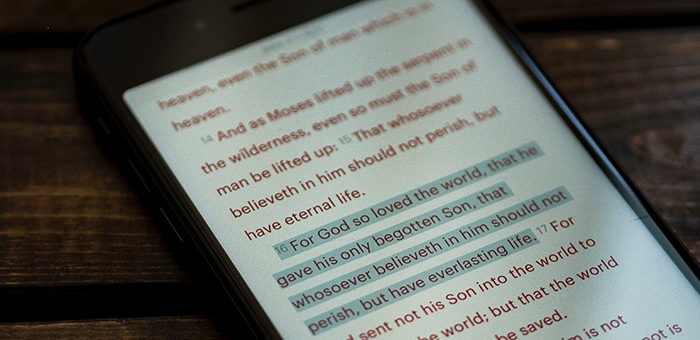This summer, book designer and illustrator Adam Lewis Greene set up a campaign on Kickstarter, an online fundraising website, hoping to raise $37,000 for his “Bibliotheca” project. A month later the donations totaled nearly $1.5 million. While not the first project rethinking how people read the Bible, its instant popularity, backed by money, signals how hungry people are for new ways to experience Scripture.
Bibliotheca takes out chapter and verse numbers, section headers, cross-references and notes, and places the biblical text in a four-volume set. The pages in each volume are formatted with one column and large margins. Essentially, the biblical volumes are designed to be read like a literary anthology.
“Reference Bibles traditionally look like dictionaries. Reader-friendly Bibles are more like novels. We’re lamenting that people don’t read their Bibles enough, and now we’ve realized the design of Bibles has an influence on that,” said J. Mark Bertrand, author of the Bible Design Blog, in Christianity Today.
Bibliotheca isn’t the first chapterless Bible. Biblica, owners of the New International Version translation, created The Books of the Bible series in 2007 that removed chapters and verses (relatively new insertions) and published the Bible in a multi-volume format. The Books of the Bible also recombined books that were previously broken in two, like 1 and 2 Samuel. Crossway followed suit this year with the release of the English Standard Version’s Reader’s Bible, which is chapterless and verseless, but is presented in one volume.
And of course, some prefer to read their Bible on their phone, tablet or computer, rather than any kind of book format. LifeChurch.tv, a large multi-site evangelical church led by Craig Groeschel, has a pastor dedicated to “innovation” and an emphasis on “digital missions.” Their desire is to expand people’s access to Scripture. The church’s most successful effort is YouVersion, the free Bible app that enables people to read the Bible anywhere they might carry their phone. As their website says, “When the Bible is always with you, it becomes a part of your daily life.”
It has become a daily part of many lives. The Bible app has been installed over 150 million times. It has 982 versions available, supports 679 languages, and has multiple interactive Bible reading plans.
Digital tools are also transforming the way thousands of Christians study the Bible. BibleGateway.com’s advanced searching capabilities help people quickly find and compare particular passages in multiple Bible translations based on the keywords, phrases, topics or Scripture references. With Lumina.Bible.org, students of the Bible can view multiple translations beside the original languages with word studies and Strong’s Exhaustive Concordance tagging. Logos Bible Software gives its customers extensive resource linking, note-taking functionality, sermon starters, and linguistic analysis for study of the Bible both in translation and in its original languages. The GloBible offers an interactive scriptural immersion experience where the text is linked with 3.5 hours of HD video, 2,300 high-res images, 140 zoomable maps, 7,500 encyclopedia articles, 650 works of art and 450 virtual tours of holy sites.
While many of these new technologies were developed, Steve Green, President of Hobby Lobby, has been recovering rare biblical texts and artifacts with the hope of expanding people’s experience of and exposure to the Bible through a Museum of the Bible. His collection is one of the world’s largest and is valued in the hundreds of millions of dollars. The yet-to-be-officially-named museum is set to open in 2017 a few blocks south of the National Mall in Washington, D.C.
The time, talents, funds and ingenuity that are expended on behalf of experiencing and sharing the Bible in many different ways speak to evangelicals’ love of the Bible. May these projects and resources lead to a renewed commitment to the God of the Bible in the nation and world.
This article originally appeared in the NAE Insight.



 View All Articles
View All Articles 




























